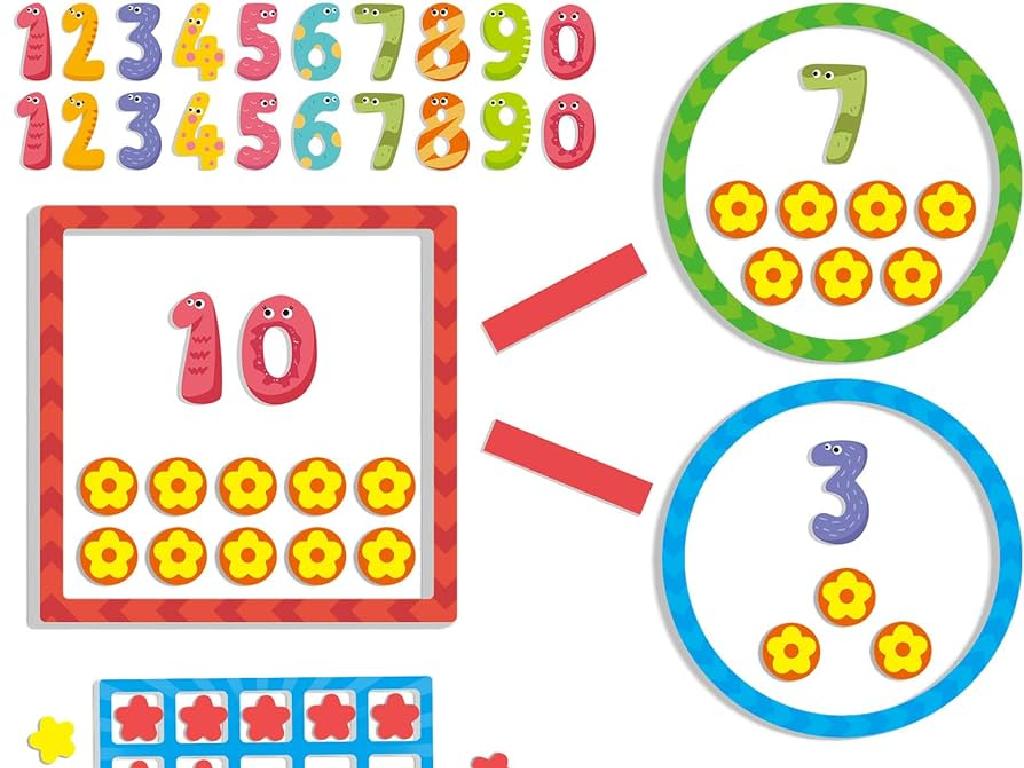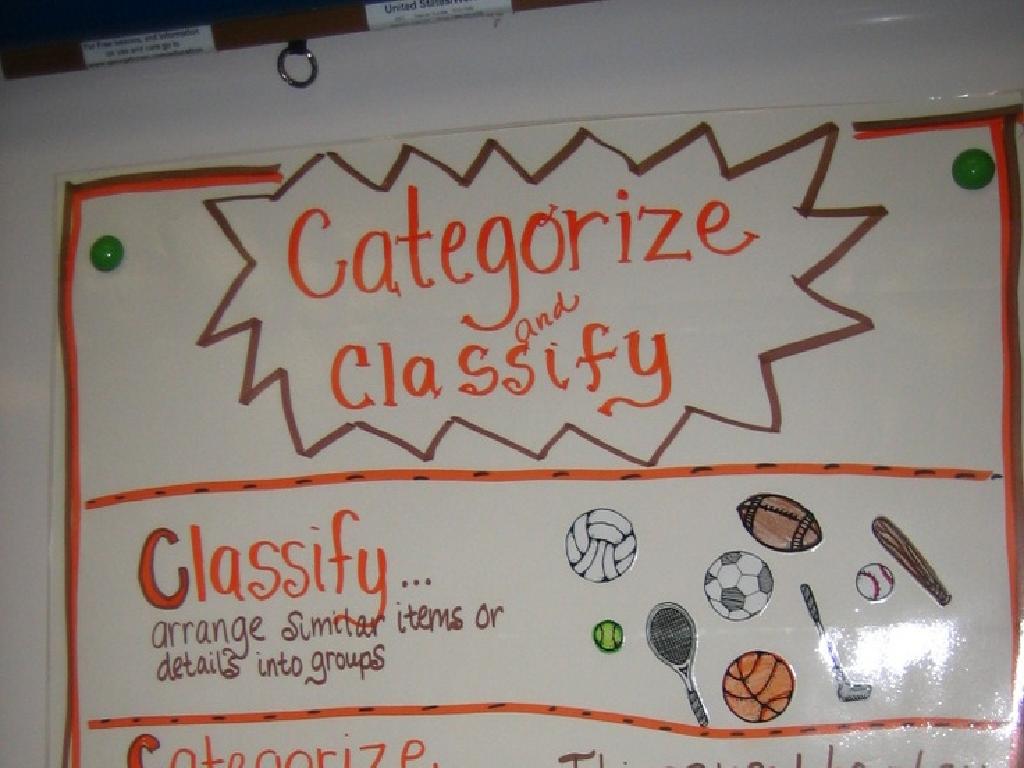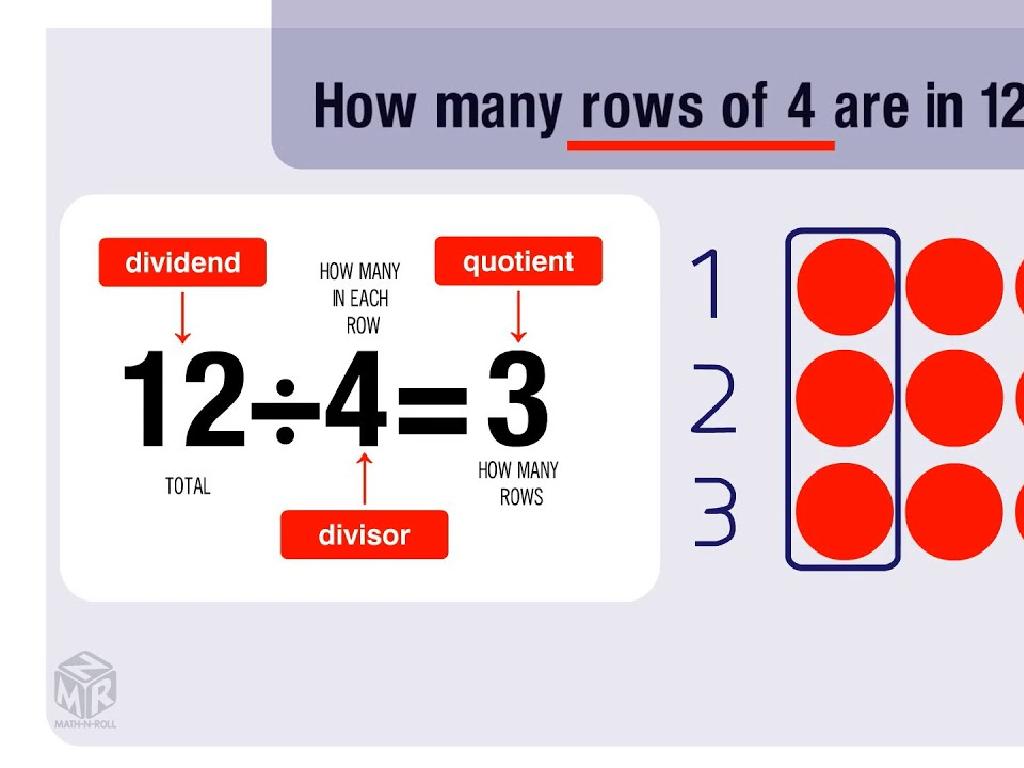Compare Customary Units By Multiplying
Subject: Math
Grade: Fifth grade
Topic: Customary Units Of Measurement
Please LOG IN to download the presentation. Access is available to registered users only.
View More Content
Today’s Adventure: Comparing Customary Units!
– Importance of measurement
Measurement is vital for cooking, building, and science.
– Review: inches, feet, yards, miles
Inches, feet, yards, and miles measure length or distance.
– Comparing units with multiplication
Use multiplication to convert between units, like feet to inches.
– Practical applications
Apply this to real-world problems, like measuring a room.
|
This slide introduces the concept of customary units of measurement and their relevance in everyday life. Begin by discussing why measurement is essential, giving examples such as cooking recipes, construction, and scientific experiments. Review the basic customary units of length inches, feet, yards, and miles to ensure students are familiar with them. Explain how to compare and convert these units using multiplication, for instance, 12 inches make a foot, so we multiply by 12 to convert feet to inches. Highlight the practicality of this skill by discussing real-life scenarios where they might need to measure and compare different lengths, such as in home projects or when planning a trip. Encourage students to think of situations where they have used or could use measurement.
Understanding Customary Units
– Customary units in the U.S.
– System of measurement used in the U.S.
– Length units: inch, foot, yard, mile
– Smaller to larger: 12 inches in a foot, 3 feet in a yard, 1760 yards in a mile
– Volume, weight, temperature units
– Gallons, pounds, and Fahrenheit are also customary units
– Comparing units by multiplying
– Use multiplication to convert between units, like feet to inches
|
This slide introduces students to the concept of customary units, which are used for measurement in the United States. It’s important for students to recognize the common units for length (inches, feet, yards, miles), as well as for volume (gallons), weight (pounds), and temperature (Fahrenheit). Emphasize the need to understand how to compare and convert these units, particularly through multiplication. For example, to find out how many inches are in 3 feet, students would multiply 3 (feet) by 12 (inches per foot). Provide practice problems for students to convert between units and ensure they understand the relationship between the different sizes of units.
The Importance of Comparing Units
– Understanding unit relationships
– Comparing units like inches to feet or gallons to quarts shows how they relate.
– Solving real-world problems
– Helps in cooking, construction, and more by knowing how to convert between units.
– Example: Feet in a mile
– How many feet are in a mile? Useful for travel distances.
– Practical applications
|
This slide aims to explain why learning to compare customary units is crucial. Understanding the relationships between different units, such as inches to feet or gallons to quarts, is fundamental in grasping the concept of measurement. It’s a skill that students will use in various real-world scenarios, from cooking to construction. For example, knowing how many feet are in a mile is essential when planning travel routes. Encourage students to think of situations where they might need to convert units and discuss the importance of accuracy in these conversions. Provide additional examples where comparing units is necessary, and highlight the practicality of this skill in everyday life.
Multiplication as a Tool for Unit Conversion
– Multiplication speeds up conversion
– Units relate as multiples of each other
– For instance, 3 feet make 1 yard
– Multiplication scales measurements
– To find larger or smaller units, multiply or divide
– Practice with real-life examples
– Convert playground dimensions from feet to yards
|
This slide introduces the concept of using multiplication as a method for converting between different customary units of measurement. Emphasize that multiplication is a quick way to scale measurements up or down, depending on the units needed. For example, if students know that 1 yard equals 3 feet, they can easily find out how many feet are in multiple yards by multiplying. Conversely, they can find out how many yards are in a given number of feet by dividing. Provide students with real-life scenarios where they might need to convert measurements, such as determining the size of a garden plot or the length of a room, to reinforce the concept.
Comparing Customary Units: Classroom Measurement
– Measuring classroom length
– Convert feet to inches
– 1 foot equals 12 inches, so 5 feet equals 60 inches.
– Classroom length in yards
– 1 yard equals 3 feet, so 30 feet equals 10 yards.
– Multiplication in unit conversion
– Use multiplication to convert between units.
|
This slide is designed for a hands-on activity where students will apply their knowledge of customary units by measuring the classroom. Start by explaining that different units can be used to measure the same length. Then, guide the students to convert 5 feet into inches by multiplying by 12, the number of inches in a foot. Next, have them convert the classroom’s length from feet to yards by dividing by 3, the number of feet in a yard. Emphasize the use of multiplication and division in these conversions. Possible activities: 1) Students measure furniture in inches and convert to feet. 2) Students estimate classroom dimensions in yards. 3) Create a conversion chart as a class. 4) Measure distances in the school hallway in feet and convert to yards. 5) Use a measuring tape to measure objects in the classroom and convert the measurements.
Conversion Practice: Customary Units
– Use a conversion chart
– Convert 24 inches to feet
– 24 inches is equal to 2 feet
– Convert 10 yards to feet
– 10 yards is the same as 30 feet
– Learn conversion factors
– Factors used to convert between units
|
This slide is aimed at helping students practice converting between different customary units using a conversion chart. Start by explaining the chart and how to use it. Then, work through the practice problems together. For example, show that 24 inches can be divided by 12, the number of inches in a foot, to get 2 feet. Similarly, demonstrate that 10 yards can be multiplied by 3, the number of feet in a yard, to get 30 feet. Emphasize the importance of understanding conversion factors, which are the numbers used to multiply or divide when converting from one unit to another. Encourage students to solve additional problems to reinforce the concept.
Group Activity: Measurement Scavenger Hunt
– Find and measure classroom items
– Use different customary units
– Inches, feet, and yards for length
– Compare measurements with a partner
– Present findings to the class
|
This interactive group activity is designed to help students understand and compare customary units of measurement by practical application. Divide the class into small groups and instruct them to find various items in the classroom to measure. They should measure each item using different units such as inches, feet, and yards. After measuring, students will compare their results with a partner to understand how the same length can be expressed in different units. Finally, each group will present their findings to the class, discussing the differences in measurements. Possible items to measure include a desk, a book, a piece of string, or the width of a window. This activity will reinforce the concept of comparing units by multiplying and provide a hands-on learning experience.
Class Activity: Create a Conversion Poster
– Design a conversion chart poster
– Chart should include length, volume, weight
– Include conversion examples
– Show how to convert between units, like inches to feet
– Use poster for solving problems
– Apply conversions to measure real objects in class
|
This activity encourages students to create a visual aid that will help them understand and memorize customary unit conversions. Provide students with the necessary conversion rates and guide them to design a poster that includes length (inches, feet, yards, miles), volume (cups, pints, quarts, gallons), and weight (ounces, pounds, tons). They should include examples of converted measurements, such as 12 inches equals 1 foot, and use these conversions to solve measurement problems. For the activity, students can measure items in the classroom and use their posters to convert these measurements into different units. This hands-on approach will reinforce their understanding of the relationship between different customary units.
Quiz Time: Customary Units Conversion
– Convert 60 inches to feet
– Remember: 12 inches = 1 foot
– Inches in 3 yards?
– 1 yard = 36 inches, so multiply 3 by 36
|
This slide is designed to assess students’ understanding of converting between different customary units of length. The first question requires students to apply their knowledge that 12 inches equal 1 foot to convert 60 inches to feet. The second question challenges them to remember that 1 yard is equivalent to 36 inches and then multiply to find the total number of inches in 3 yards. Encourage students to show their work for each problem and explain their thought process. This will help reinforce their understanding of the relationship between inches, feet, and yards. Possible activities for different students could include converting other measurements, such as yards to miles or feet to inches, to provide additional practice.
Conclusion: Mastering Customary Units
– Excellent work on unit comparison!
– Always select the appropriate unit
– Inches for small lengths, miles for distance
– Practice is key to conversion skills
– Try more examples to get better
– Keep practicing different units!
– Gallons for liquid, pounds for weight
|
As we wrap up today’s lesson on comparing customary units by multiplying, it’s important to reinforce the concept that choosing the correct unit of measurement is crucial for accuracy. Remind students that regular practice with converting and comparing units will help solidify their understanding. Encourage them to use real-world examples, like measuring ingredients for a recipe or calculating the distance for a family trip, to apply what they’ve learned. Provide additional worksheets and interactive activities to continue their practice at home.






